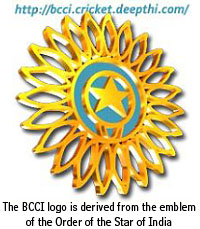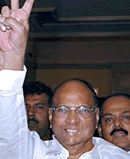

Board of Control for Cricket in India
BCCI, India
 The Board of Control for Cricket in India, or BCCI, is the governing body for cricket in India. This is India's richest sporting body. The President of BCCI is Sharad Pawar (elected 29 November, 2005). Niranjan Shah is the secretary.
The Board of Control for Cricket in India, or BCCI, is the governing body for cricket in India. This is India's richest sporting body. The President of BCCI is Sharad Pawar (elected 29 November, 2005). Niranjan Shah is the secretary.
All the office-bearers for the year 2004-05, were elected at the annual general meeting of the Board held in Kolkata.
On January 10, 2005, the Supreme Court of India ordered the removal of Jagmohan Dalmiya from the post of patron-in-chief of BCCI and also asked the board to complete its annual general meeting (AGM) which had been adjourned on September 30, 2004.
The legality of the office-bearer's election at the board's annual general meeting (AGM) held on September 29, 2004 is subjudice.
BCCI Cricket News, November 2005

Pawar wins India board presidency
Nov 29 2005
Federal government minister Sharad Pawar has been elected as president of India's Board of Control for Cricket.
Pawar ousted incumbent Ranbir Singh Mahendra by 20 votes to 11 to reverse the result of last year's election.
The outcome is a significant blow to BCCI patron Jagmohan Dalmiya, who used his casting vote for Mahendra after the 2004 election was tied.
Dalmiya has been the most powerful man in Indian cricket for two decades but he appears isolated after the election of Pawar supporters in other key roles.
Niranjan Shah and MP Pandove will be secretary and joint secretary and N Srinivasan the next treasurer of world cricket's richest sporting body.
Pawar, who first became involved in cricket in 2001 when he defeated former India captain Ajit Wadekar to become president of the Mumbai Cricket Association, said he knew "how to keep politics and cricket separate".
Farooq Abdullah, one of Pawar's closest supporters and former chief minister of Kashmir, promised a new transparency in the way Indian cricket is run.
The elections also resulted in major changes to the selection panel for the national team.
Pranob Roy, Yashpal Sharma and Gopal Sharma, believed to be the three men who lobbied for former captain Sourav Ganguly to be recalled to the squad for this week's first Test against Sri Lanka, have all lost their posts.
They have been replaced by Ranjib Biswal, Sanjay Jagdale and Bhupinder Singh, none of whom has played Test cricket, with former wicket-keeper Kiran More remaining as chief selector.
Cricket in India
Cricket is the unofficial national sport of India, and its development has been closely tied up with the history of the country, mirroring many of the political and cultural developments around issues such as race, caste, religion and nationality. Though cricket is indubitably the most popular sport in India, it is not the nation's national sport (a distinction held by field hockey).Cricket, like field hockey, was first introduced to India by the British. The earliest recorded match was played in 17211 by British sailors on shore leave. With the expansion of British rule throughout the subcontinent, the British took the game with them wherever they went. However, the early history of the game was focused largely on the large cities, particularly Bombay (now Mumbai).
The first Indians to play the game at a high level were the Parsi minority in Bombay. Beginning in 1892, an annual match was played between the Parsis and the Europeans. In 1907, this became a triangular tournament with the Hindus fielding a team, and in 1912 a Muslim team entered what was for twenty years the biggest tournament in Indiathe Bombay Quadrangular.
Among the biggest stars in the early years of Indian cricket were the four Palwankar brothers, Shivram, Ganpat and Vithal but particularly the slow left-arm bowler, Palwankar Baloo. This was particularly noteworthy as the Palwankars were from one of the untouchable castes. Treated as equals on the cricket field, off-field they often faced discrimination. This changed slowly; however, Palwankar Vithal did eventually captain the Hindu team in the quadrangular.
The formation of the Board of Control for Cricket in India in 1929 led to a first Test match with England three years later. In 1935, the Ranji Trophy began; it continues to the present as the leading regional tournament in India, with each state fielding a team. The trophy was a deliberate attempt to avoid the communalism of the quadrangular tournament.
The Indian cricket team has won one Cricket World Cup, in 1983. India also reached the finals in 2003, but lost to Australia. In recent years, Indian cricket has been marked by the intense and occasionally violent rivalry with Pakistan. Furthermore, there were several scandals related to match fixing and gambling, but these were not restricted to India; they plagued several different teams.
International cricket in India generally does not follow a fixed pattern like, for example, the English schedule under which the nation tours other countries during winter and plays at home during the summer. Generally, there has recently been a tendency to play more one-day matches than Test matches.



